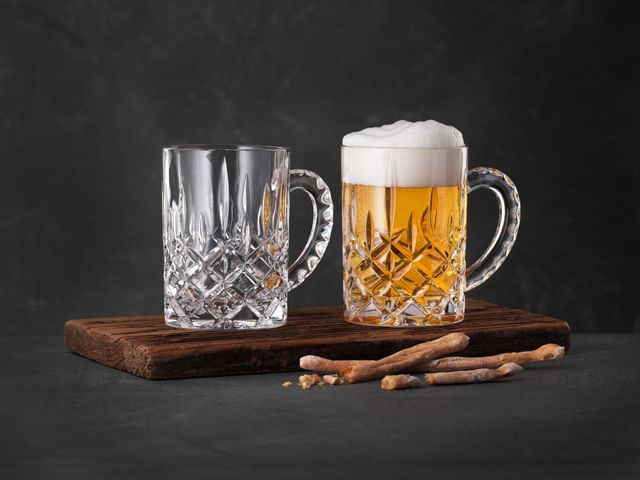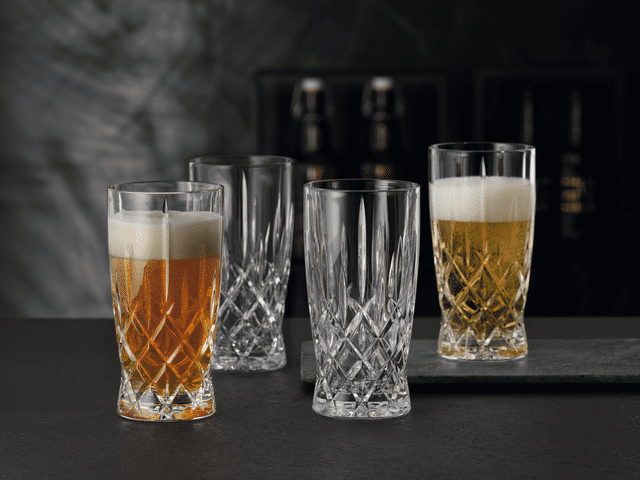All About Bavarian Beer

At NACHTMANN, we're proud of our Bavarian roots, and when it comes to Bavarian beverages, beer is the first thing that springs to mind. Also known as Bayerisches Bier, Bavarian beer symbolizes Germany's rich brewing heritage and has earned global acclaim for its exceptional taste and quality. With options ranging from pale, malty Helles beers to rich, dark Dunkel beer, you're spoiled for choice when looking for excellent Bavarian beers to enjoy from your NACHTMANN crystal glassware. In this blog, we'll cover the history of Bavarian beer brewing, beer styles you might encounter, plus some fascinating trivia you can impress your beer-loving friends with.
A background to Bavarian beer
How is Bavarian beer defined? Bavarian beer is any beer brewed in the Bavaria region of Germany. This region is in the country's southeast and includes major cities such as Munich and Nuremberg. It's also where our NACHTMANN headquarters in Neustadt an der Waldnaab are based!
The roots of Bavarian beer brewing can be traced to the Middle Ages when monks played a significant role in the art of beer brewing. Monastic breweries thrived in Bavaria, refining brewing techniques and producing exceptional beer. It was here that the oldest still-existing brewery in the world was founded - the Bayerische Staatsbrauerei Weihenstephan, founded as a Benedictine monastery brewery in 1040, located on the Weihenstephan hill in Freising.
Fast-forward a few hundred years to 1516, and a defining rule was introduced for Bavarian beer. Duke Wilhelm IV of Bavaria issued the Reinheitsgebot (the German Beer Purity Law) - a groundbreaking regulation that permitted only the following four ingredients in beer:
- water
- malted barley
- hops
- yeast
This law laid the foundation for Bavarian beer's reputation for purity and quality, and it is still influential in brewing practices today.
Another contributing factor to the flourishing of Bavarian beer culture was the introduction of beer gardens in the 19th century. These gardens provided a place for locals and visitors to enjoy a cold brew amidst nature.
Moreover, the world-renowned Oktoberfest, which takes place annually in Munich, started in 1810, showcasing the region's love for beer. Today this event brings people together from all corners of the globe to celebrate Bavarian beer and culture, solidifying Bavarian beer's place in popular culture.
Bavarian beer styles and qualities
With their rich history and global popularity, it's no surprise that Bavarian breweries produce a wide array of beer styles, each with unique qualities and characteristics. Over 40 types of beer are brewed in Bavaria in total, accounting for roughly 25% of all beer produced in Germany. Some of Bavaria's most popular styles that stand out among the pack include the following:

Bavarian Helles
Bavarian Helles beer is one of the more recently-introduced German beer styles, first introduced in the late 19th century in response to the growing popularity of Pilsner-style beers from the Czech Republic. Bavarian Helles is a pale lager with balanced maltiness and moderate hop bitterness. It showcases a brilliant golden color with a creamy head, offering a smooth and crisp taste.
The easy-to-drink nature of Helles beer makes it a popular choice among locals and tourists alike. If you're a lager lover, Helles Beer displays similar qualities, plus a fuller body, making it an excellent next step to take if you're looking to begin expanding your beer repertoire.
Weissbier (Wheat Beer)
One of Bavaria's signature styles, Weissbier (which translates to 'white beer' in English) is a longstanding mainstay of German beer culture, having been produced there for several centuries. Weissbier is made with a substantial proportion of malted wheat, resulting in a hazy appearance and a light, fruity taste, often accompanied by notes of banana, clove, and other spices.
As such an iconic style, variations of Weissbier are famous in their own right, such as Hefeweizen (unfiltered wheat beer with yeast) and Kristallweizen (filtered wheat beer), which offer contrasting experiences. The best way to find out which type of Weissbier best suits your tastebuds? Try them all out!

Dunkel
Dunkel is another beer style that has been prevalent in Germany for several centuries, having been produced since the late medieval period (around the 14th century).
Dunkel, meaning "dark" in German, is a dark lager with a rich malt profile, including chocolate, toffee, and roasted grains flavors. As a dark lager, you might expect Dunkel to be a full-bodied beer that could overwhelm less experienced beer drinkers, but that isn't the case at all! Despite its darker appearance, Dunkel beers typically maintain a smooth and clean finish with a medium body, offering a pleasant surprise to those expecting a heavy beer.
Bock
Bock beer has been produced in Germany since the 14th century but was adapted by Bavarian brewers in the 1800s to make the distinctive Bock beer style recognized widely today. The term "bock" is derived from the German word "Einbeck," the town where this beer style first originated.
Bock beers are strong, malty lagers with a slightly sweet taste. Bavarian bocks, like Doppelbock and Eisbock, typically have a higher alcohol content, providing warmth and richness during the colder months, which is perhaps why Bock beers are often enjoyed in celebration of special occasions.
Bavarian Beer Trivia
To round things off, here are a few additional Bavarian beer facts you can use next time you want to impress with your beer trivia know-how:
- The Reinheitsgebot that dictated how pure beer must be applied initially only to beer brewing in Bavaria but later became a nationwide regulation in Germany. So Bavaria has had considerable influence over beermaking in Germany as a whole!
- Bavarian beer steins, traditionally made of stoneware, were designed with hinged lids to protect the beer from insects, and they often featured decorative and symbolic designs.
- Munich's beer halls, such as the Hofbräuhaus, have been serving beer for centuries and have witnessed notable historical figures, including Mozart and Lenin.
- If you're looking for some authentic Bavarian foods to enjoy alongside your Bavarian beer, some popular options to consider include pretzels; traditional Bavarian sausages such as weisswurst and bratwurst; obatzda - a Bavarian cheese spread made from camembert or brie cheese, butter, onions, and seasonings, and Hendl - a Bavarian roast chicken, seasoned with herbs and spices, which is a popular dish at beer gardens and festivals.
Bavarian beer stands as a testament to centuries of brewing craftsmanship, cultural significance, and unique qualities that continue to delight beer enthusiasts worldwide. From its historical roots in monastic breweries to modern beer gardens and festivals, Bavarian beer has stood the test of time to remain a symbol of brewing excellence. Whether you're sipping a refreshing Helles on a warm summer day or enjoying a robust Bock during the festive season, every glass of Bavarian beer offers a taste of tradition and quality. Prost!
Locations